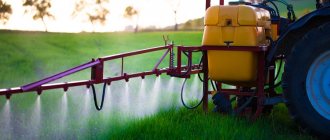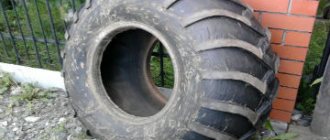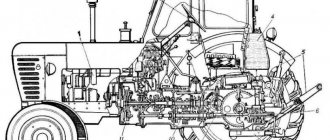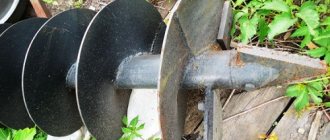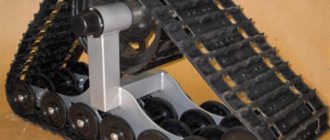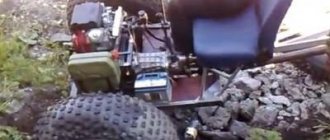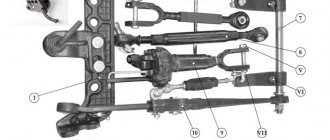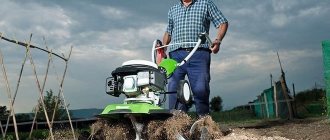A sprayer on a mini tractor makes it easier to water fields with anti-pest substances. Depending on the task at hand, such devices differ in design, volume and method of attachment to the agricultural machine. You can buy a professional unit or make it yourself from available materials.
Types of structures and principle of operation
The design consists of several main parts - the frame, chassis, hydraulics and a tank containing fluids. The latter is always placed in the rear of the car. Spraying can be either jet or rain. There are 3 types of designs:
- Sprayer mounted on a tractor hitch. It is installed on the machine itself, but because of this the working volume is limited (no more than 800 liters). The device can process lines up to 18 m wide. This option is in demand in small or hard-to-reach farms because the main advantages are compactness and mobility. The only disadvantage we can highlight is low performance due to the fact that you have to frequently replenish the tank.
- Tow hitch. Area of application: fields larger than 1 thousand hectares. It differs from the previous type in that here the sprayer needs to be attached to the tractor. The working volume reaches 2-3 thousand liters, but the driver needs to constantly monitor the car, because it easily gets stuck in mud and has difficulty moving over uneven terrain.
- Self-propelled car. This is a professional and expensive equipment specialized in spraying pesticides and water. Used only on large plantations (over 1.5 thousand hectares). It has maximum performance, but it is almost impossible to make the device with your own hands due to the complexity of the design.
Popular models
There is a wide range of battery-powered electric sprayers on the market. Let's highlight several options:
- Umnitsa OE-10L-N 10 L is a sprayer with a battery, having a volume of 10 l and a weight without liquid of 4.57 kg. Designed for weed control, removal of pests on grass and trees, window treatment and car washing. Modern developments were used in the production, guaranteeing maximum efficiency in comparison with mechanical devices. The model has a regulator for changing the spray activity, a two-meter hose and a large neck for filling liquid. The tank is made of plastic. Productivity is 2.1 liters per minute, battery capacity is 3.3 mAh.
- Comfort Clever. Electric sprayer with battery. OE-16L-N. This model has a 16-liter tank and a battery with an increased charge level of 8 mAh. The set comes with an adjustable telescopic steel rod. The kit also includes a removable filter, a neck, a 150 cm long tube and other parameters. In the manufacture of the tank, high-quality plastic was used, resistant to various chemical components. There is a removable filter installed inside to protect against contamination. The model is reliable and easy to use.
- Electric sprayer “Umnitsa” OE-2L. This is a compact device with a small tank measuring 2 liters. The battery has a small capacity of 2.2 mAh. The product has a portable design, which allows it to be used in hard-to-reach places. The advantages include high performance, low fluid consumption and minimal weight. The casing has a built-in button for turning it on and off, there is an LCD display and an indicator showing the liquid level.
- Caiman Fog King PS20E is a battery-powered sprayer weighing 5 kg. A 4 Ah lithium-ion battery is installed inside. The capacity of the container is 20 liters. Liquid is dispensed at a rate of 1.5 liters per minute. A backpack strap is provided for carrying. The model is suitable for disinfection and spraying of various plants. The generated pressure of 10 bar is sufficient for effective application.
An electric sprayer is a multifunctional device that allows you to fight weeds and pests, quickly wash windows and a car, and also solve other problems. The main thing is to choose wisely and buy a model taking into account real requirements and tasks.
Advantages and disadvantages of a homemade device
The strengths of homemade equipment include the ability to configure the machine for use in local conditions, adapt the tank to the needs of the farm (volume, working substances, etc.).
Production will not require a lot of money, because the sprayer is equipped with parts from standard auto stores. Also device:
- Easily adjustable in width, which allows you to use the equipment for processing fields with different row frequencies;
- quickly repaired, because the design is simple and durable;
- can be used with any type of agricultural machinery.
Among the shortcomings are:
- The need for frequent repairs and replacement of parts.
- The need to check the bottom before each trip, because... Due to cheap materials, it deteriorates due to corrosion.
DIY creation
Making your own equipment to protect fields from pests does not require special knowledge or equipment. Enough with standard tools. The process will take 2-3 days.
Consumables and tools
The master will need a number of details:
- Capacity. It can be a plastic or wooden barrel, but it is better to choose a metal tank.
- Thick pipes with a rectangular cross-section.
- Small polyvinyl chloride tube.
- Iron corners for installation.
- Electric pump.
Diagram and assembly
Schemes and drawings from the Internet should not be trusted, because the author and his competence are unknown. It is recommended to familiarize yourself with the documents of professional equipment.
The build process looks like this:
- First, the frame is welded from steel corners. The design must be supplemented with tubes with holes made in them for spraying liquid.
- A container for substances is installed. It must be attached with thick bolts so that the tank holds tightly.
- Inside the tank it remains to connect the electric pump.
If desired, you can make the rod of homemade equipment movable, which will make it easier and faster to set up watering. To produce it, you need to take a screw that is used in a car jack.
The control will be carried out using hydraulics.
Tractor mounting
Installation of the finished tool on agricultural machinery will not take more than 5 minutes. The tank is attached to the platform at the rear of the tractor with bolts or welding. It is recommended to use the first option, because... in this case it will be easier to repair the unit.
How to make it yourself
For a person with at least a little knowledge of technology, it is obvious that in general there is nothing complicated in the design of the sprayer. This means that you can save a significant amount of money and, instead of buying a ready-made spray gun, make it yourself.
At the same time, the finished model will maximally perform the specific tasks that are supposed to be solved with its help.
Homemade sprayer: video
In this case, two approaches are possible. The first is to use ready-made parts in your work, which can be purchased at any specialized agricultural equipment store, and act on the principle of a children's construction set.
The resulting spray gun will cost slightly less than buying a ready-made one. The second is to achieve maximum savings by finding use for available materials, parts removed from the car, etc.
One way or another we will need:
- tank for working solution - a metal container or plastic barrel of the desired volume;
- round PVC tubes, profiles, other metal parts for making a frame;
- steel corners with rectangular and round sections;
- sprayers (ordinary spool valves, which can be found at any tire service station, are perfect for this purpose);
- 12 volt electric pump (this is the optimal power to achieve the required pressure).
Important! The electric pump is the most expensive device in a sprayer. In order not to buy a ready-made device, you can adapt an old car electric pump or a pump from a chainsaw for these purposes.
Required tools:
- welding machine;
- metal scissors;
- electric drill or screwdriver;
- hammer;
- pliers;
- measuring tool.
Let's get started:
- We place the pump inside the tank.
- We make a frame of suitable dimensions from a corner, pipes and a metal profile.
- We weld the platform onto the frame on which the tank will need to be installed.
- We fix the tank on the platform.
- We install sprayers on the pipes.
- We attach the pipes with sprayers to the tank.
- We attach the finished sprayer to the tractor hitch. The drive to the pump is supplied through the PTO (the unit that transmits rotation from the motor to the attachment, it is found on all tractors), and the lifting and lowering of the sprayer is provided by the hydraulic system.
Such a simple device, made with your own hands, can provide fairly high-quality processing of fairly large areas. Of course, it’s not worth using it on an industrial scale, but for a plot of 40-50 acres it’s an excellent economical option!
The best sprayer companies
Each company produces equipment for a specific area, special climate, etc. For example, machines from the domestic developer Zarya are well suited for Russian fields. They differ from foreign analogues in their cost-effectiveness and durability. Other advantages include:
- Stabilization systems that allow you to work at high speed.
- 4-stage substance filtration system.
- Painting technologies that protect metal from rust.
- Mechanism for constant mixing of liquid.
Another good company advertised in the media is Jarmet. She is located in Poland. It produces machines for chemically treating beds and spraying liquid fertilizers. They are equipped with a filtration system (property protection), an additional container for hand washing, and an equipment rod regulator with a manual or hydraulic mechanism.
Among the companies engaged in self-propelled sprayers, the following stand out:
- Buhler-Versatile. The SX280 has auxiliary booms, proprietary software to simplify field processing, and an autopilot. The vehicle uses a powerful engine that meets the American Tier 4 emission standard. The vehicle comes with iron and polyurethane tanks.
- Case IH. The Patriot model, equipped with a stabilization system, is popular. A suspension is used that adapts to changes in terrain. The maximum speed reaches 48 km per hour, and the tank holds no more than 4500 thousand liters.
The equipment in these companies is sold retail and wholesale. In the latter case, a discount is offered (10-30%).
Method No. 2
We offer a version of a manual sprayer made from scrap materials. As a tank for liquid, you can use a tank from an old washing machine. This element is usually made of stainless steel, therefore it will be inert to pesticides and chemical fertilizers.
In addition, such tanks have sufficient capacity, so it is enough to process a medium-sized garden plot.
The tank can be installed on an old cart to make it easier to move the structure around the site. The tank is attached to the trolley frame using threaded connections. To supply fluid under pressure, you will need an oil pump from a passenger car.
The pump will be powered by a small electric motor, which is more economical than diesel and gasoline counterparts. The drive is provided by a belt drive; for this purpose, the motor shaft is equipped with a small pulley, and the pump shaft is equipped with a large one.
The pump is installed inside the tank, the motor outside. We attach a copper tube to the pump, which we connect to the sprayer hose. The engine can be powered by a battery or an electric cable.
We recommend the second option so as not to make the structure heavier. Note that the cable length must be at least 30-40 meters so that the sprayer reaches all corners of the site.
The advantage of this design is that it does not use spray nozzles. This is a rather expensive part that often gets clogged. The disadvantages include the inability to regulate the supply and spraying of liquid.
